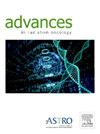肾细胞癌的颅外姑息性放射治疗
IF 2.7
Q3 ONCOLOGY
引用次数: 0
摘要
目的:症状管理是肾细胞癌(RCC)患者护理的一个组成部分。我们在不同种族的患者群体中评估放射治疗(RT)的疗效和影响症状的因素。方法和材料对2011年至2022年在三级转诊中心接受RT治疗的症状性颅外RCC转移患者进行了一项机构审查委员会批准的回顾性审查。症状分为疼痛、神经系统(感觉异常或无力)、呼吸系统(呼吸困难、咯血或咳嗽)和胃肠道/泌尿生殖系统(GI/GU)出血。从RT开始测量症状缓解的时间,并在治疗和随访期间进行评估。进行描述性和生存分析。结果240例有症状的RCC患者接受了RT治疗,其中93.0%为疼痛,4.0%为神经系统,4.1%为呼吸系统,1.6%为GI/GU出血。6个月时,84.0%的患者症状改善(95%可信区间[CI], 80.4-87.2%)。在症状类别中,6个月时疼痛改善率为84.6% (95% CI, 81.0-87.9%), 6个月时呼吸系统症状改善率为69.9%(49.3-88.0%),6个月时神经系统症状改善率为88.6%(69.6-98.1%),1个月时GI/GU出血改善率为37.5%(13.9-77.1%)。总体缓解和疼痛缓解的中位时间分别为1.6个月(范围,1.4-1.9)和1.6个月(范围,1.4-1.9)。尽管立体定向放疗和常规放疗获得疼痛缓解的几率相似,但出乎意料的是,常规放疗的症状缓解更快(P < .001)。结论立体定向放射治疗和常规放射治疗对转移性肾细胞癌患者的症状均有缓解作用。本文章由计算机程序翻译,如有差异,请以英文原文为准。
Extracranial Palliative Radiation Therapy for Renal Cell Carcinoma
Purpose
Symptom management is an integral component of care for patients with renal cell carcinoma (RCC). We evaluated the efficacy of radiation therapy (RT) and factors influencing symptom in an ethnically diverse patient population.
Methods and Materials
An institutional review board-approved retrospective review was conducted of patients with symptomatic extracranial RCC metastases treated with RT between 2011 and 2022 at a tertiary referral center. Symptoms were categorized as pain, neurologic (paresthesia or weakness), respiratory (dyspnea, hemoptysis, or cough) and gastrointestinal/genitourinary (GI/GU) bleeding. Time to symptom alleviation was measured from the start of RT and assessed during-treatment and follow-up visits. Descriptive and survival analyses were performed. Associations between symptom relief and treatment parameters were evaluated by generalized estimating equations
Results
We identified 240 symptomatic RCC patients who received RT to 581 metastases including 93.0% for pain, 4.0% for neurologic, 4.1% for respiratory, and 1.6% for GI/GU bleeding. Symptom improvement was observed in 84.0% of patients overall at 6 months (95% confidence interval [CI], 80.4-87.2%). Among symptom categories, pain improved in 84.6% (95% CI, 81.0-87.9%) at 6 months, respiratory symptoms in 69.9% (49.3-88.0%) at 6 months, neurologic symptoms in 88.6% (69.6-98.1%) at 6 months, and GI/GU bleeding in 37.5% (13.9-77.1%) at 1 month. The median times to overall and pain alleviation were 1.6 months (range, 1.4-1.9) and 1.6 months (range, 1.4-1.9), respectively. Although the odds of achieving pain palliation were similar between stereotactic and conventional RT, unexpectedly, symptom relief occurred more quickly with conventional RT (P < .001).
Conclusions
Stereotactic and conventional RT are effective for symptom palliation for patients with metastatic RCC.
求助全文
通过发布文献求助,成功后即可免费获取论文全文。
去求助
来源期刊

Advances in Radiation Oncology
Medicine-Radiology, Nuclear Medicine and Imaging
CiteScore
4.60
自引率
4.30%
发文量
208
审稿时长
98 days
期刊介绍:
The purpose of Advances is to provide information for clinicians who use radiation therapy by publishing: Clinical trial reports and reanalyses. Basic science original reports. Manuscripts examining health services research, comparative and cost effectiveness research, and systematic reviews. Case reports documenting unusual problems and solutions. High quality multi and single institutional series, as well as other novel retrospective hypothesis generating series. Timely critical reviews on important topics in radiation oncology, such as side effects. Articles reporting the natural history of disease and patterns of failure, particularly as they relate to treatment volume delineation. Articles on safety and quality in radiation therapy. Essays on clinical experience. Articles on practice transformation in radiation oncology, in particular: Aspects of health policy that may impact the future practice of radiation oncology. How information technology, such as data analytics and systems innovations, will change radiation oncology practice. Articles on imaging as they relate to radiation therapy treatment.
 求助内容:
求助内容: 应助结果提醒方式:
应助结果提醒方式:


